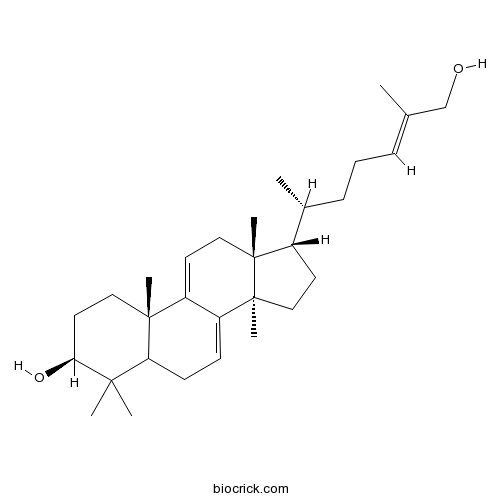A tetracyclic triterpenoid that is lanosta-7,9(11),24-triene which is substituted by hydroxy groups at positions 3 and 27. It has been isolated from several Ganoderma species.
InChI=1S/C30H48O2/c1-20(19-31)9-8-10-21(2)22-13-17-30(7)24-11-12-25-27(3,4)26(32)15-16-28(25,5)23(24)14-18-29(22,30)6/h9,11,14,21-22,25-26,31-32H,8,10,12-13,15-19H2,1-7H3/b20-9+/t21-,22+,25?,26+,28-,29-,30+/m1/s1
Ganoderol B with 5α-reductase inhibitory activity and the ability to bind to androgen receptor (AR) can inhibit androgen-induced LNCaP cell growth and suppress regrowth of the ventral prostate induced by testosterone in rats, suggests that ganoderol B might be useful in prostate cancer and benign prostatic hyperplasia (BPH) therapy through suppressing the function of androgen and its receptor.[1]
Ganoderol B, isolated from the fruiting body of Ganoderma lucidum, is a potent α-glucosidase inhibitor, and α-Glucosidase inhibitor has considerable potential as a diabetes mellitus type 2 drug because it prevents the digestion of carbohydrates, suggests that ganoderol B could be a diabetes mellitus type 2 drug.[2]
Ganoderol B inhibits LNCaP cell expressed androgen receptor (AR), the inhibitory activity caused by its anti-androgen effect.[3]
English website: Ganoderol B
Japanese website: Ganoderol B
Chinese website: Ganoderol B
[1] Liu J, Shimizu K, Konishi F, et al. Bioorgan Med Chem, 2007, 15(14):4966-72.
[2] Fatmawati S, Shimizu K, Kondo R. Phytomed Int J Phytother Phytopharmacol, 2011, 18(12):1053-5.
[3] Zhang J, Zhang H, Jia W, et al. Chinese fungi Society 2015 Annual Conference Abstract Book. 2015.
[4] Zhao J, Zhang X, Li S, et al. J Sep Sci, 2006, 29(17):2609-15.



